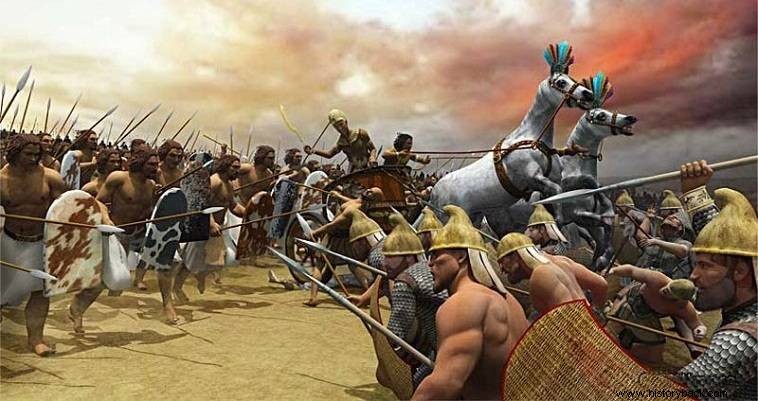
Although the term "Lightning War" is a product of the 20th century, its beginnings as a military doctrine, as well as its applications in practice, on the various battlefields, are ancient. The doctrine of the Lightning War is essentially as old as man on Earth. Each time, however, the means and conditions of its implementation differed, factors that decisively influenced its failure or success in practice.
It was only after the domestication of the horse that ancient generals possessed the means to conduct truly lightning campaigns, since speed is a key component of Lightning War. The discovery of the chariot, combined with the domestication of the horse, created new data.
In addition to speed, for the implementation of this particular doctrine, a series of other parameters had to apply - deception, surprise, local even numerical superiority, strategic information, prohibition of information to the opponent - exactly what must apply until today. Why didn't the Germans discover the doctrine of Blitzkrieg in World War II. It's just that the Germans seem to have been better scholars of history at that time.
Doctrine and Application
The doctrine of blitzkrieg is based on three parameters, which must apply, at least to some extent, simultaneously. These parameters are timeless and are axioms in military art. Primary parameter is power. Without power there can be no victory.
Second parameter is the speed. Speed disrupts the opponent, limiting their reaction times. The third parameter is exploitation. Success that does not receive the corresponding exploitation automatically loses its value.
These parameters were and are still valid, unchanged, until today. Those generals, from the beginning of time, who understood them and applied them, achieved brilliant results. Of course, the means are also important, the appropriate means each time, which make possible the application of the particular doctrine.
Also a very important factor is the appropriate training and morale of the troops that will be called upon to implement such a strategy. Finally, an even more important factor is the disorientation of the opponent, his deception, surprise.
Throughout time, the doctrine of blitzkrieg was almost always applied by armies with superior strategic or even tactical agility of their opponents. The overall strength of the army always played a secondary role, since the primary role was played by local superiority, i.e. the ability of an army to gather in a specific place and time, overwhelmingly superior forces to the opponent.
Speed also had to be superior to the opponent, allowing the active army to win the battle of concentration and surprise.
From infantry to horse taming
The first mythological records of battles come, chronologically, from ancient Mesopotamia, from the Sumerian civilization. The Sumerian city-states early developed regular armies, consisting of a core of standing officers and men – the various royal guards.
Something similar happened in other areas as well – and in Greece (Sesklou culture). The first armies consisted exclusively of infantry, mainly light. The light infantry was able to move faster than the heavy, not only because it was more lightly equipped – in those days there was no armor anyway – but because its philosophy of action dictated it. Both the Sumerians and the early Greeks developed a large number of light infantry from the 5th millennium BC.
The light infantry was the first fast-moving corps and indeed regardless of terrain - unlike tanks, cavalry, or even modern motorized forces. It was a multi-mission weapon. An important event for human history was about to change the whole perspective. It was the domestication of equines and the horse.
Everything changed after the introduction of tanks into the arsenals of the armies of the time. Real empires were born based on the new weapon. The first advocates of lightning war were the Hittites, the Mitanni and the Hyksos. The Hittites, from the time they permanently settled in the central plateau of Asia Minor, developed a large number of chariots.
War tanks
Unlike their Sumerian and Akkadian successors in the region, the Hittites fielded large numbers of chariots, which proved to be the ideal weapon that allowed the expansion of their empire from the coasts of Asia Minor to Babylon.
Also, the inhabitants of today's Palestine had since the beginning of the 2nd millennium BC. large number of chariots, influenced by the Mitans, the first "chariot empire".
The Mitan empire extended into what is now northern Iraq, as far as Turkish-ruled Kurdistan. Her army had few and untrained infantry and many well-manned tanks. These were the so-called "Marianos", the elite warriors of the chariots.
But the chariots of the Mitans were not striking instruments, as the warriors were armed with bows. They were fast-moving instruments of fire, which, however, due to the opponent's inability to deal with them, constituted the decisive instrument of the battle.
In contrast, the Hittites had shock chariots – just like the Greeks – whose warriors were armed with long spears. In 1596 BC the Hittite king Myrsilos, with a lightning campaign, conquered the entire region from Sebastia in today's Turkey, up to Babylon. About a hundred years earlier, the Hyksos invaded Egypt and conquered a large part of it.
However, the most famous conquerors who used the doctrine of blitzkrieg were the Assyrians. Carrying out a series of lightning campaigns, the Assyrian kings such as Sargon, Esahardon or Ashurbanibmal (the Sardanapalus of the ancient Greeks), crushed every opponent in their path.
It is worth noting that Assyria collapsed when faced with a coalition between the Babylonians, who at the time also had heavy chariots, respectively the Assyrians, the Medes who had a lot of elite cavalry and the Scythians, who had the best light cavalry in history.
